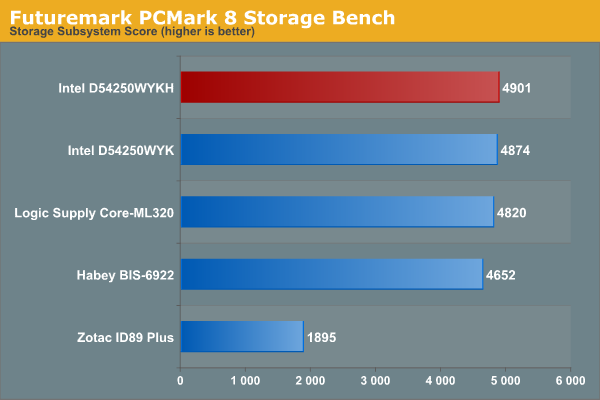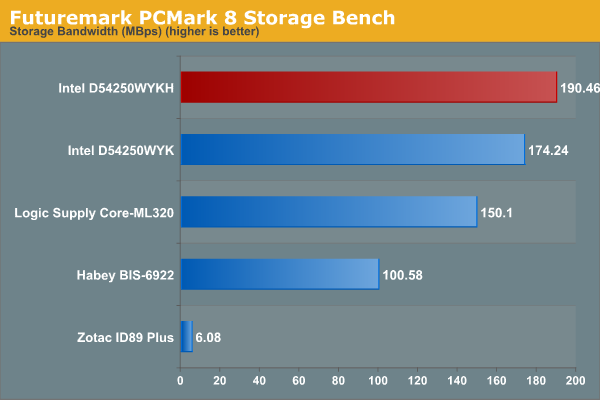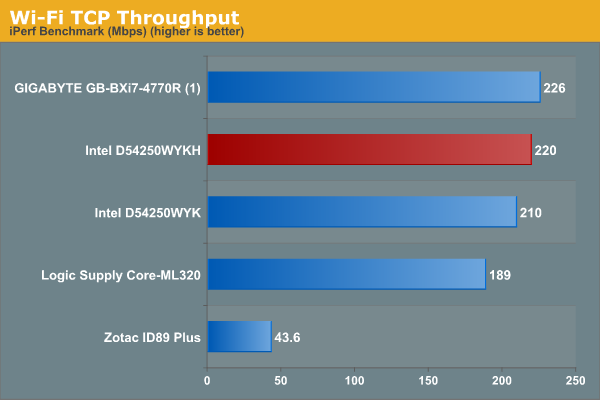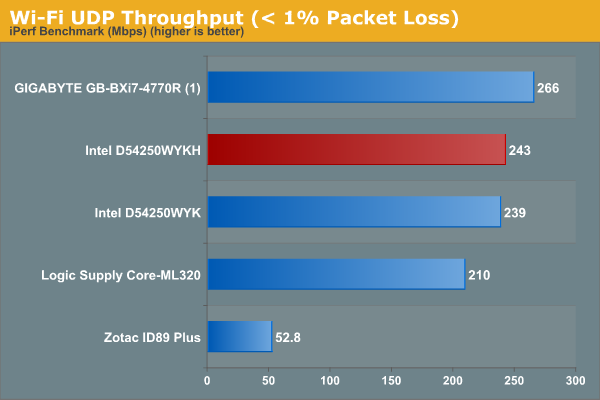Intel D54250WYKH Haswell NUC Kit with 2.5" Drive Slot Mini-Review
by Ganesh T S on May 18, 2014 10:15 AM ESTStorage & Wireless Networking Credentials
We have recently started devoting a separate section to analyze the storage and networking credentials of the units under review. On the storage side, one option would be repetition of our strenuous SSD review tests on the drive(s) in the PC. Fortunately, to avoid that overkill, PCMark 8 has a storage bench where certain common workloads such as loading games and document processing are replayed on the target drive. Results are presented in two forms, one being a benchmark number and the other, a bandwidth figure. We ran the PCMark 8 storage bench on selected PCs and the results are presented below.


On the networking side, we restricted ourselves to the evaluation of the WLAN component. Our standard test router is the Netgear R7000 Nighthawk configured with both 2.4 GHz and 5 GHz networks. The router is placed approximately 20 ft. away, separated by a drywall (as in a typical US building). A wired client (Zotac ID89-Plus) is connected to the R7000 and serves as one endpoint for iPerf evaluation. The PC under test is made to connect to either the 5 GHz (preferred) or 2.4 GHz SSID and iPerf tests are conducted for both TCP and UDP transfers. It is ensured that the PC under test is the only wireless client for the Netgear R7000. We evaluate total throughput for up to 32 simultaneous TCP connections using iPerf and present the highest number in the graph below.

In the UDP case, we try to transfer data at the highest rate possible for which we get less than 1% packet loss.











36 Comments
View All Comments
osamabinrobot - Sunday, May 18, 2014 - link
I just built this unit for myself at work and have been digging it.kgh00007 - Sunday, May 18, 2014 - link
Just some further information for anyone looking to buy one of these.This nuc can actually run 2133MHz RAM (G.Skill Ripjaws) and the TDP can also be increased in the bios or using the Intel Extreme Tunig Utility. Its possible to increase the TDP from 15W to 25W or 30W by adjusting the Sustained Mode Power Limit in the bios. This can also be done dynamically with the Intel XTU and be set to load different TDP's on a per app basis.
This is pretty cool and improves gaming on the nuc considerably as it allows the iGPU to sustain higher clocks. Temps remain the same, around 80degC, but the fan noise does increase a lot as the fan ramps up. I have it set to increase the TDP to 25W for games but to remain at 15W the rest of the time. As far as I know only the i5 versions of the nuc have these adjustments.
I'm really happy with my nuc hooked up to the living room TV, its an awesome little machine.
And mine did come with a power cord!
Aikouka - Sunday, May 18, 2014 - link
Amazon actually has a toggle to switch between units with and without a power cord. When I bought my first i3 Haswell NUC, it came without a power cord, but Amazon was rather generous in giving me a partial refund on it, which was more than enough to buy a cable.ganeshts - Sunday, May 18, 2014 - link
Thanks for the extra info. Pretty sure readers would love to experiment with this feature. To be frank, I wasn't even aware of this and Intel never advertised in their briefings / brochures.kgh00007 - Tuesday, May 20, 2014 - link
No worries!skiboysteve - Monday, May 19, 2014 - link
Wow I am doing this for sure. I have my NUC in a very loud industrial rack.MonkeyPaw - Monday, May 19, 2014 - link
I have an i5 Haswell Yoga 2, and it even has a "dust cleaning" mode. I haven't had to use it, but my guess is it ramps the fan up to clean out the cooling area. Pretty nice if it actually works.extide - Monday, May 19, 2014 - link
Typically dust cleaning modes actually run the fans in reverse for a little while.SeanFL - Sunday, May 18, 2014 - link
Built one of these a couple months back for audio editing and it works great. Quite pleased with the performance and the size is amazing. Went with the Samsung 840 evo msata on a recent build and it's even more impressive.Aikouka - Sunday, May 18, 2014 - link
Ganesh, what Wi-Fi drivers did you use? I'm curious because I own two i3 NUCs, and while I use the same Intel card in both and the same router (FW V1.0.3.24_1.1.20), the performance is awful. It only connects via 802.11n, and while the performance might be alright for a bit, it usually degrades into 1-5Mbps -- but it doesn't actually transmit anything. I've been tempted to try different drivers, but I just end up getting annoyed by the whole thing and plugging in an Ethernet cable. =POn that note, I have noticed some odd issues with the Nighthawk. For example, I use a rather awkward generated password for my WiFi, and I don't feel like typing it in on devices like a PS Vita or a 3DS. So, I use WPS to set it up. Unfortunately, WPS on the Nighthawk seems to wreak havoc on the router's WiFi system as it just becomes incredibly unresponsive after using WPS.